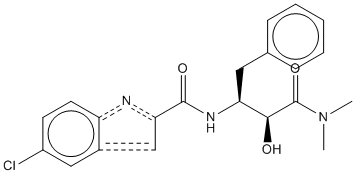All AbMole products are for research use only, cannot be used for human consumption.

CP-91149 is a human liver glycogen phosphorylase α (HLGPα) inhibitor with an IC50 of 0.13 μM in the presence of 7.5 mM glucose. CP-91149 suppressed glucagon-triggered glycogenolysis in isolated rat hepatocytes and in primary human hepatocytes. In vivo, oral injection of CP-91149 to diabetic ob/ob mice at 25–50 mg/kg led in rapid (3 h) glucose lowering by 100–120 mg/dl without producing hypoglycemia. In addition, upon treatment with CP-91149, A549 non-small cell lung carcinoma (NSCLC) cells accumulated glycogen with associated growth retardation. Treated normal skin fibroblasts also accumulated glycogen with G1-cell cycle arrest that was associated with inhibition of cyclin E-CDK2 activity. Overall, cells expressing high levels of brain GP were growth prevented by CP-91149 associating with glycogen accumulation whereas cells expressing low levels of brain GP were not affected by the agent.
| Cell Experiment | |
|---|---|
| Cell lines | HSF55 and T98G |
| Preparation method | Exposing cells to various concentrations of CP-91149 for 72hours. Determining viability with manual cell counts following staining with trypan blue exclusion assay. Fixing cells with 70% ethanol. Staining DNA with propidium iodide and the intensity of fluorescence is measured using a Becton-Dickinson flow cytometer at 488nm for excitation and at 650nm for emission. Using Modifit's Sync Wizard is analyze the cell cycle profile . |
| Concentrations | Dissolved in DMSO, final concentrations ~50 μM |
| Incubation time | 72 hours |
| Animal Experiment | |
|---|---|
| Animal models | Obese, diabetic male C57BL/6J-Lep(ob/ob) mice and their lean, nondiabetic C57BL/6J-/+ littermates |
| Formulation | Formulated in vehicle consisting of either 0.25% (wt/vol) methyl cellulose in water or 0.1% Pluronic P105 Block Copolymer Surfactant in 0.1% saline |
| Dosages | ~50 mg/kg |
| Administration | Orally |
| Molecular Weight | 399.87 |
| Formula | C21H22ClN3O3 |
| CAS Number | 186392-40-5 |
| Solubility (25°C) | DMSO 70 mg/mL |
| Storage |
Powder -20°C 3 years ; 4°C 2 years In solvent -80°C 6 months ; -20°C 1 month |
| Related Products |
|---|
| 2-Deoxy-2-fluoro-D-glucose
2-Deoxy-2-fluoro-D-glucose is a radiolabeled glucose analog, which is commonly used in medical imaging techniques such as positron emission tomography (PET) scans. |
| 2-Bromo-4-chlorophenylacetic acid
2-Bromo-4-chlorophenylacetic acid is a biochemical reagent. |
| CPN-351 TFA
CPN-351 TFA is a selective pentapeptide antagonist of human NMUR1 with a pA2 of 7.35. CPN-351 TFA can be used for the research of inflammation. |
| 5-Phenyluracil
5-Phenyluracil is a pyrimidine derivative, a class of heterocyclic aromatic organic compounds crucial in biochemistry. It serves as a synthetic nucleoside analogue, meaning it mimics the structure of naturally occurring nucleosides like uridine. This structural similarity allows it to participate in biochemical reactions, often interfering with normal cellular processes, making it a valuable tool in studying nucleic acid metabolism and developing antiviral and anticancer agents. |
| 7-Deoxyloganin
7-Deoxyloganin is a biosynthetic precursor of Loganin. 7-Deoxyloganin undergoes hydroxylation catalyzed by 7-deoxyloganin 7-hydroxylase, a cytochrome P450-dependent monooxygenase, to produce Loganin. |
All AbMole products are for research use only, cannot be used for human consumption or veterinary use. We do not provide products or services to individuals. Please comply with the intended use and do not use AbMole products for any other purpose.


Products are for research use only. Not for human use. We do not sell to patients.
© Copyright 2010-2024 AbMole BioScience. All Rights Reserved.
